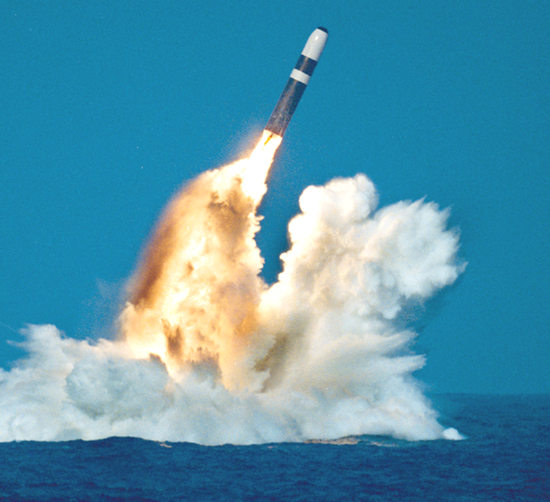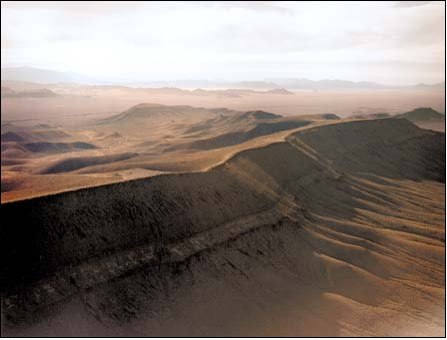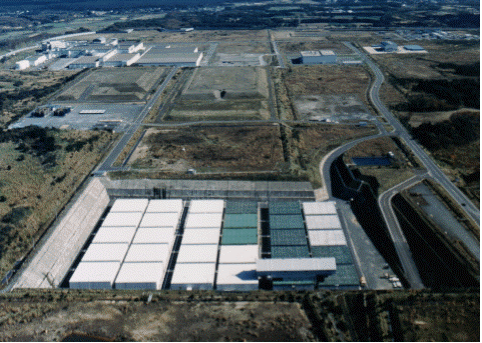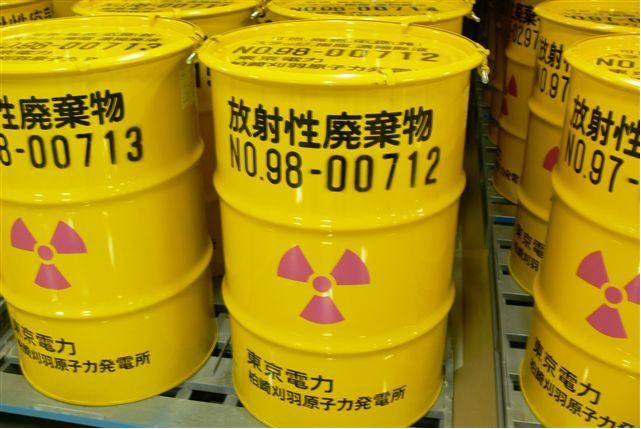Gavan McCormack
It is 63 years since mushroom clouds over Hiroshima and Nagasaki ushered in the nuclear age. The attacks on the two cities are now solemnly commemorated on 6 and 9 August, when the two city mayors issue their messages calling on the world to disarm, messages as necessary as they are certain to be ignored by the powers.
 “Fire’, Panel 2 of the Hiroshima Panels, by Iri and Toshi Maruki (Collection of the Hiroshima Panels Foundation Maruki Gallery)
“Fire’, Panel 2 of the Hiroshima Panels, by Iri and Toshi Maruki (Collection of the Hiroshima Panels Foundation Maruki Gallery)
The five nuclear club members, led by the single super-power, refuse to carry out their obligation under the 1968 Non-Proliferation Treaty (actually an abolition treaty) to demolish their arsenals. At the most recent, five year, review meeting of the organization in 2005, they insisted that the function of the treaty be confined to blocking outsiders, other than those such as Israel, India and Pakistan to whom de facto honorary membership has been extended, from admission. The NNPT (Nuclear Non-Proliferation Treaty) becomes the NPPT (Nuclear Privilege Protection Treaty).
Super-powers and regional powers alike, unable to envisage their security without nuclear weapons, will therefore politely acknowledge but ignore the Hiroshima and Nagasaki Declarations. In the teeth of powerful citizen opposition, the British Labour government has already decided to maintain (renew) its Trident nuclear submarine-based “deterrent” into at least the mid 21st century.
 Britain’s Trident II D5 missile
Britain’s Trident II D5 missile
Other middle-level states (including Japan and Australia) likewise put their faith in nuclear weapons, believing that their security would be compromised were it not for the protection of an ally’s nuclear “umbrella.” States frozen out of the system and facing hostile relations with one or other “major” power follow the same logic and make every effort to join the club. Faith in nuclear weapons has thus become near universal. Global society seems to have become inured, even de-sensitized, to nuclear weapons. Global security in the 21st century continues to rest on the very substance that most threatens it.
But there is a new dimension to the nuclear threat, one that the Hiroshima and Nagasaki declarations will likely pass over lightly, if they mention it at all. The world leaders who yesterday gave us plutonium-based security today point to the threat of global warming and climate catastrophe and offer a formula for survival: one based on plutonium. A nuclear “renaissance” lies ahead since, according to President George W. Bush, nuclear energy is “clean” and “renewable” and nuclear plants “are the best solution to making sure we have economic growth and at the same time [are] good stewards of the environment.” Nuclear energy, the byproduct of the search for the ultimate weapon of mass destruction, will be the salvation of humankind.
Levels of nuclear dependence in electricity supply vary greatly across the world, with a global average around 16 per cent. In the UK, US, Japan, South Korea, and France, it is 18, 19, 35, 40, and 78 per cent respectively. Although the industry has been in the doldrums for decades, following the near catastrophes of Three Mile Island in 1979 and Chernobyl in 1986, the Bush administration now insists that technology has advanced to the point of being able to guarantee virtual safety.
In February 2006, Washington announced a Global Nuclear Energy Partnership (GNEP), a kind of nuclear energy “coalition of the willing” to control the production, processing, storage, sale, and disposal of nuclear materials and to offer facilities to the rest of the world on a lease basis, side-stepping the existing UN-centred international control framework. At US urging, 20 countries have thus far signed a GNEP Statement of Principles that “embraces the development and use of reprocessing technology and contains no commitment on the part of its members to limit the spread of sensitive nuclear fuel cycle technology such as reprocessing plants.” [1] The call for world-wide expansion of the nuclear industry reverses three decades of anti-proliferation policy on the part of the global superpower.
“Renaissance” talk spreads excitement in the nuclear industry and on the part of governments around the world. Contracts for the construction of four new reactors were awarded in the US earlier this year; Japan has two reactors under construction, four at the final stages of regulatory review, and an additional seven that “may be built over the next decade.” [2] In Africa from Libya, Algeria and Tunisia to Namibia and Nigeria, through the Persian Gulf countries to Indonesia and Thailand, and beyond to India and China, the GNEP stirs bureaucratic visions of endless clean power. India and China plan to multiply their nuclear capacity by six-fold and 8-fold respectively,
However, the idea that nuclear energy might be the answer to climate change is far-fetched. As the existing generation of reactors, mostly in the US, Europe, and Russia, reaches their “use by” date, about 80 new reactors would have to be commissioned over the next ten years and a further 200 in the decade after that, just to maintain the existing nuclear contribution to world energy needs. [3] And, according to Greenpeace, even if the world’s current 439 reactors were to be doubled by 2030, carbon dioxide emissions would only be cut by 5 per cent and greenhouse gases by 3 per cent. To make a real difference on emissions would require thousands upon thousands of new reactors, something which, quite apart from the risk factor, in engineering terms is inconceivable. [4]
The Bush administration’s GNEP agenda also includes a technology known as ABR (Advanced Breeder Reactor), but the ABR exists only as a theoretical proposition whose commercial development is at best decades in the future. Breeder programs, which “breed” (i.e. produce more than they start with) very pure, weapons-grade plutonium had been abandoned everywhere save Japan on grounds of cost (four to five times as much as conventional plants) and safety, till thus resuscitated.
The GNEP switch to the world-wide promotion of the nuclear option neglects the fact that this system, which is to be spread around the earth, can only barely be made to function in the most advanced industrial countries. Finland, commencing construction in 2002 of Olkiluoto-3, Europe’s first nuclear plant since Chernobyl, has experienced engineering problems significant enough to delay its completion by two years (to 2011) and greatly raise its cost. Sweden’s Forsmark 3 reactor is said in 2006 to have gone within half an hour of meltdown.
 Inside the Forsmark reactor, Sweden
Inside the Forsmark reactor, Sweden
France’s EDF power plant spilled 75 kg of uranium into local water systems at Tricastin in July 2008. In Japan in July 2007 the world’s biggest reactor, at Kashiwazaki-Kariwa in Niigata, was struck by an earthquake 6.8 times stronger than was allowed for by the design and it was found to have been constructed directly atop a fault line.
If, despite its long record of nuclear engineering and its technical sophistication, even Japan makes disastrous miscalculations, can the rest of the world be expected to do much better? Japan’s nuclear record includes serious design failures, data falsification and fabrication, cover-ups, and the failure to report criticality incidents and emergency shut-downs.
No state, however, is more enthusiastic than Japan about embracing the nuclear option. Present plans call for nuclear power dependence to be raised from 35 to 40 per cent of electric supply. [5] More importantly, it strives to attain the full nuclear cycle – enrichment, generation, reprocessing, and waste disposal. METI (Ministry of Economics, Trade and Industry)’s New National Energy Policy of 2006 declares the goal of having Japan become a “nuclear state” (genshiryoku rikkoku). So well-recovered from its nuclear “allergy” is once nuclear-victim Japan that it now sets out to lead the world into a plutonium-based future.
Already Japan possesses more than 45 metric tons of plutonium (about 6 MT in Japan itself and 39 MT outside the country) – 750 times the 60-odd kgs that North Korea might or might not possess, and about one fifth of global stocks. Ignoring pleas from the Director-General of the IAEA to desist from enrichment and reprocessing works, [6] it is about to commence full commercial processing of plutonium at Rokkasho in Northern Japan, reducing annually 800 tons of reactor wastes to five more tons of plutonium, or 500 nuclear weapons-worth. This plant has already cost around 20 billion dollars to construct and is expected to cost around 180 billion dollars over 40 years of its use, thus becoming one of the most expensive industrial facilities ever built. Every day, it will discharge into the adjacent sea and sky wastes equivalent in volume to one year’s worth of a nuclear reactor.
Japan has also long pursued the goal of a fast-breeder plutonium reactor. It began to construct the Monju prototype (at Tsuruga in Fukui) in 1985, but had to suspend work in 1995 following a major accident and cover-up. It is not expected to resume test operations until October 2008. The attraction for resource-poor Japan of a potentially eternal source of energy at a time of skyrocketing oil and gas prices is obvious, but the risks and the costs are also evident. According to the Nuclear Power Policy Outline of 2005, it will be 2050 at the earliest before Monju could be supplying any electricity to the grid.
 The Monju Prototype Fast Breeder Reactor, Fukui Prefecture
The Monju Prototype Fast Breeder Reactor, Fukui Prefecture
From September 2008 Japan also welcomes the American nuclear aircraft-carrier George Washington to “home-port” in Yokosuka, within a few dozen kilometers of the capital. The welcome may be muted by the news in August 2008 that the nuclear submarine, USS Houston, had been leaking radioactive material into Pacific waters en route to and from the port of Sasebo in southern Japan for months undetected.
South Korea has for the past 30 years been following Japan down the nuclear path. Having developed indigenous nuclear technology, it now has 8 reactors under construction and another 9 under consideration. Its plans call for electricity generation capacity to be doubled from its current 30 per cent to 60 per cent by 2035. The Shin Kori 3 reactor in South Gyeongsang Province has a 1,400 KW capacity, roughly 280 times North Korea’s Yongbyon. [7] Like the US, Japan and France, Korea gears up to compete for the lucrative reactor export market, and is said to enjoy good prospects of success in Turkey, Romania and Indonesia. The Korean public appears more concerned over the possibility of being supplied tainted beef by US exporters than by any nuclear risk.
Yet, despite the promise of eternal green energy by the prophets of the nuclear renaissance, nuclear power takes much longer than any renewable response to global warming, involves significantly increased greenhouse gas emissions during its construction, mining, processing and disposal phases, is accompanied by unquantifiable risk (proliferation, terrorism, earthquake or other natural catastrophe, accident), and its wastes remain toxic for millennia.
Plutonium (Pu239) has a half-life of 24,000 years and depleted uranium a half-life of 4.5 billion years. All nuclear countries confront the problem of how to handle such toxic substances. As Britain sets about clearing up its half century of nuclear works, it faces an estimated $140 billion cost for decommissioning its civil nuclear works, with the cleanup of Sellafield reprocessing plant expected to take about 112 years. In addition, health costs now and in centuries to come are impossible to calculate. Radiation levels ten times normal have been reported in the Sellafield vicinity, child leukaemia levels in parts of North Wales are ten times the national average, and high concentrations of the carcinogenic iodine 129 are to be found as far away as the coasts of Denmark and Sweden.
The US Congress in 1987 chose Yucca Mountain in Nevada (160 kms northwest of Las Vegas) as site for its long-term, high-level nuclear waste repository, but after 21 years it is still hard to say when, if ever, the site will open. The Department of Energy (DoE) says it will cost $90 billion and projects opening in 2017, but Senate Majority Leader Harry Reid (D-Nevada) says it will never open. [8] A federal court ruled in 2004 that it was not enough to provide assurances against radiation risk to humans for 10,000 years; the frame had to extend to one million years (sic). The DoE is confident that it can meet that standard, [9] but who can dare promise security for up to a million years, a span as long as human existence itself?
In Japan too the search goes on for a long-term repository. Gradually, the country’s northern and eastern districts around the Rokkasho plants are being transformed into a vast, poisonous complex, over which generation after generation, for millennia, a heavy, militarized guard must be maintained.
Rokkasho Nuclear Waste Storage and Reprocessing Facility
Bizarrely, it even seems possible now that local government authorities in depopulated, mountain or coastal villages may be swayed by fiscal incentives of the most blatant and short-term political kind to embrace the nuclear waste option, committing their home towns and villages to become wasteland for the coming million years, for ever that is.
The future nuclear state can only be centralized, heavily policed or militarized, non-, if not anti-democratic, and a continuing and growing threat to humanity. The Bush administration’s GNEP, belittling cost, technical feasibility, and risk, offers the nightmare prospect of the global spread of nuclear technology and materials. The nuclear reactor is as false a response to global warming as the nuclear weapon is to global security.
Notes
[1] Edwin Lyman and Frank N. von Hippel, “Reprocessing Revisited: The International Dimensions of the Global Nuclear Energy Partnership,” Arms Control Association, April 2008.
[2] Emma Chanlett-Avery and Mary Beth Nikitin, “Japan’s Nuclear Future: Policy debate, prospects, and U.S. Interests,” CRS Report for Congress, 9 May 2008, Washington: Congressional Research Service, p. 4.
[3] “Nuclear power for civilian and military use,” Le Monde Diplomatique, Planet in peril, Arendal Norway, UNEP/1GRID-Arendal, 2006, p. 16.
[4] One “senior US official” is quoted as saying that it would take between 1,000 and 2,500 new reactors by 2050 to reduce global carbon emissions by 50 per cent. Kiryu Hiroto, “Samitto o genpatsu suishin no ba ni shite wa ikenai,” Shukan kinyobi, 27 June 2008, pp. 28-29.
[5] For the current figure of 35 percent: Chanlett-Avery and Nikitin, cit.
[6] Mohammed Elbaradei, “Seven steps to revive world security,” The Financial Times, 2 February 2005. Japan took the position that its program was not new and was therefore exempt from the call for moratorium.
[7] Korea Herald, 4 June 2008.
[8] Quoted in Lyman and von Hippel, and see Senator Reid’s home page.
[9] “EPA proposes radiation limits for Yucca Mountain,” Sciencenow, American Association for the Advancement of Science, 10 August 2005.
Gavan McCormack is a coordinator of Japan Focus and author of Client State: Japan in the American Embrace (New York, Verso, 2007, with Japanese, Chinese and Korean editions in press). This text is an expanded version of his August essay for the Korean vernacular newspaper, Kyunghyang sinmun, where it is to be published on 6 August, “Hiroshima Day.” See also his article on “Japan as a Plutonium Superpower”. Posted at Japan Focus on August 4, 2008.








